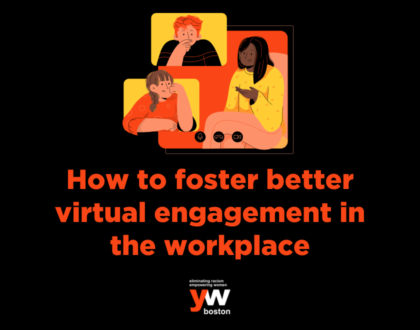How to foster better virtual engagement in the workplace

Earlier this year, we covered seven ways to make virtual meetings more inclusive. Now, as more and more organizations extend their remote work plans into 2021, we have compiled a few pointers for leaders and supervisors searching for ways to foster more meaningful online engagement with their employees. Keeping employees engaged in online spaces is critical to staying socially connected while physically distant. Here are some things to consider when interacting with your employees using digital mediums.
What is virtual engagement?
First, let’s define what we mean by “virtual engagement.” Virtual engagement refers to all and any employee interactions that occur online, whether those are “live” and synchronous or asynchronous.
Synchronous engagement: Communication that occurs simultaneously at a fixed time interval such as video conferencing and voice calls.
Asynchronous engagement: Communication that occurs at different times without fixed time intervals such as chat, message boards, and emails.
Virtual engagement vs. active resistance
In the online realm, active and passive engagement appear a bit differently. It’s important not to confuse passive engagement with active resistance. While someone may have their camera off during a video call, for instance, that does not mean they are not fully engaged. As employees juggle new variables such as sharing their remote workspaces, increased caregiving responsibilities, and other challenges arising from working remotely during a pandemic, employers must remain flexible and empathetic during this time.
Active and passive engagement: participating via microphone, camera, or messages; answering questions; providing feedback; taking notes.
Active resistance: being distracted; multi-tasking during the majority of the meeting; shutting down or not providing sufficient space for feedback and inquiries.
Measuring virtual engagement

Measuring virtual engagement is a necessary step for readjusting and making modifications that will improve the quality of your interactions. As a facilitator, check in with participants to see how they are feeling, what their energy level is like, and to learn whether they feel prepared for the meeting or virtual presentation they are about to participate in. If you are providing new information, be sure to check for understanding. And at the end of the meeting, check in again to see if people’s disposition or feelings have changed, and to see if they want to provide any feedback. In addition to asking for feedback from participants, make note of your own observations such as how many people participated, how often did people participate, did anyone seem to dominate the conversation, and so on.
7 tips to increase engagement in virtual meetings
- Familiarize yourself with virtual platforms before facilitating or participating in a meeting. As much as possible, avoid troubleshooting during a meeting or presentation. If necessary, host a practice run, review a tutorial, or identify a virtual assistant who can help you.
- Be present, participate to the best of your ability, and minimize as many distractions as possible. Turn off email and other notifications, silence your phone, maximize the virtual meeting to full screen, etc.
- Remember to mute your microphone when you are not speaking so that you don’t distract others when they share their responses.
- Hosts, be patient with the pacing of the session. It is okay if there are “awkward” silences, don’t feel obligated to fill those. Let others, and yourself, reflect and process information.
- Practice active listening. Acknowledge people when they speak, make “eye contact” by looking at your webcam, nod or provide reaffirmations via chat, etc.
- Practice active participation. Don’t let facilitators carry the entire conversation. Others want to hear from you.
- When it comes to facilitating virtual conversations—especially when covering topics like politics and social identities such as race, ethnicity, and gender—it is crucial to establish shared language and frameworks and to prioritize building trust and relationships.
- Provide different ways to participate or provide feedback. As a way to account for monotony, different communication styles, power dynamics, etc., try to experiment with technology that can enhance engagement and virtual learning. Options include virtual whiteboards, visual live polls, and visual collaboration tools.
As part of YW Boston’s Diversity, Equity & Inclusion Services, our staff facilitates virtual dialogues and workshops on topics related to race, ethnicity, gender, and workplace inclusion. Through InclusionBoston as well as our DEI Workshops, we’ve found that trust, relationship building, and regular check-ins are necessary components of successful virtual interactions. In order to achieve this, YW Boston facilitators model behavior for participants to follow and draw personal connections to foster better engagement. Click here to learn more about InclusionBoston.
______
About YW Boston
As the first YWCA in the nation, YW Boston has been at the forefront of advancing equity for over 150 years. Through our DE&I services—InclusionBoston and LeadBoston—as well as our advocacy work and youth programming, we help individuals and organizations change policies, practices, attitudes, and behaviors with a goal of creating more inclusive environments where women, people of color, and especially women of color can succeed.
During this time, YW Boston is working to provide organizations with digital workshops and resources to help them better understand the challenges faced by their employees. As part of that work, we are helping organizations become socially connected while staying physically distant. For more information, please contact Sheera Bornstein at sheera@ywboston.org.
